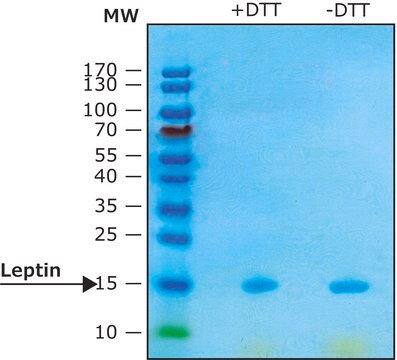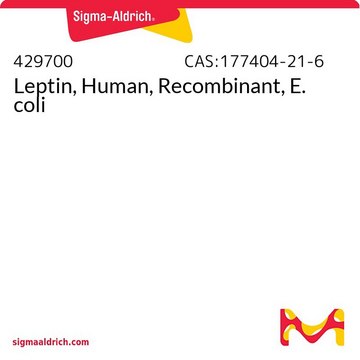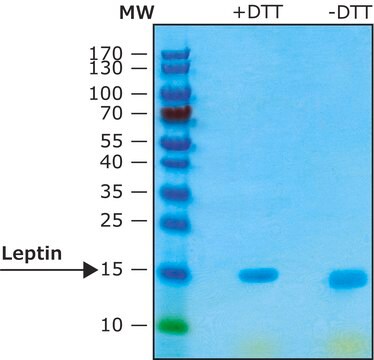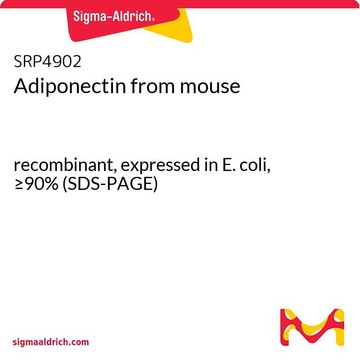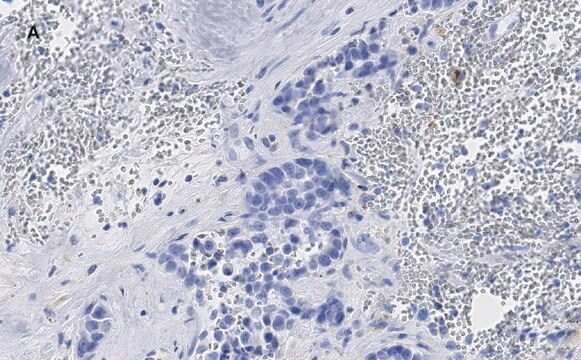L3772
Leptin from mouse
≥98% (SDS-PAGE), recombinant, expressed in E. coli, lyophilized powder
Sinonimo/i:
OB
About This Item
Prodotti consigliati
Origine biologica
mouse
Livello qualitativo
Ricombinante
expressed in E. coli
Sterilità
non-sterile
Saggio
≥98% (SDS-PAGE)
Stato
lyophilized powder
Potenza
≤1.0 ng/mL ED50
PM
predicted mol wt ~16 kDa
Condizioni di stoccaggio
OK to freeze
tecniche
cell based assay: suitable
Impurezze
≤1.0 EU/μg endotoxin
N° accesso UniProt
Condizioni di spedizione
ambient
Temperatura di conservazione
−20°C
Stringa SMILE
CC(C)CC(C(=NC(CCC(=N)O)C(=NCC(=NC(CO)C(=NC(CC(C)C)C(=NC(CCC(=N)O)C(=NC(CC(=O)O)C(=NC(CCSC)C(=NC(CC(C)C)C(=NC(CC1=CNC2=CC=CC=C21)C(=NC(CCC(=N)O)C(=NC(CC(C)C)C(=NC(CC(=O)O)C(=NC(CC(C)C)C(=NC(CO)C(=O)N3CCCC3C(=NCC(=NC(CS)C(=O)O)O)O)O)O)O)O)O)O)O)O)O)O)O)O)O)O)N
InChI
1S/C87H138N22O28S2/c1-41(2)27-48(88)72(121)97-50(18-21-65(89)112)73(122)93-36-68(115)95-61(38-110)84(133)104-54(28-42(3)4)77(126)98-52(20-23-67(91)114)75(124)106-59(33-70(117)118)82(131)100-53(24-26-139-11)76(125)102-55(29-43(5)6)78(127)105-58(32-46-35-92-49-16-13-12-15-47(46)49)81(130)99-51(19-22-66(90)113)74(123)101-56(30-44(7)8)79(128)107-60(34-71(119)120)83(132)103-57(31-45(9)10)80(129)108-62(39-111)86(135)109-25-14-17-64(109)85(134)94-37-69(116)96-63(40-138)87(136)137/h12-13,15-16,35,41-45,48,50-64,92,110-111,138H,14,17-34,36-40,88H2,1-11H3,(H2,89,112)(H2,90,113)(H2,91,114)(H,93,122)(H,94,134)(H,95,115)(H,96,116)(H,97,121)(H,98,126)(H,99,130)(H,100,131)(H,101,123)(H,102,125)(H,103,132)(H,104,133)(H,105,127)(H,106,124)(H,107,128)(H,108,129)(H,117,118)(H,119,120)(H,136,137)/t48-,50-,51-,52-,53-,54-,55-,56-,57-,58-,59-,60-,61-,62-,63-,64-/m0/s1
NRYBAZVQPHGZNS-ZSOCWYAHSA-N
Informazioni sul gene
mouse ... Lep(16846)
Categorie correlate
Descrizione generale
Leptin (Ob) is a non-glycosylated polypeptide hormone. It is produced primarily in adipocytes and the placenta. The structure of leptin closely resembles members of the long-chain helical cytokine family. It is composed of four antiparallel α-helices interconnected by two long crossover links and one short loop. These structural elements are arranged in a left-handed helical bundle formation, resulting in a unique two-layer packing configuration.
Applicazioni
- to check the effect of leptin on ovulation for treating infertility in obese mice
- to check the effect of leptin on MGARP (mitochondria-localized glutamic acid-rich protein) expression in testis and follicular granular cells of mice
- to study the morphometrical changes in mouse testicular tissue upon long term exposure to leptin
Azioni biochim/fisiol
Human and mouse leptin share ~84% sequence identity.
Stato fisico
Risultati analitici
Codice della classe di stoccaggio
11 - Combustible Solids
Classe di pericolosità dell'acqua (WGK)
WGK 3
Punto d’infiammabilità (°F)
Not applicable
Punto d’infiammabilità (°C)
Not applicable
Dispositivi di protezione individuale
Eyeshields, Gloves, type N95 (US)
Scegli una delle versioni più recenti:
Possiedi già questo prodotto?
I documenti relativi ai prodotti acquistati recentemente sono disponibili nell’Archivio dei documenti.
I clienti hanno visto anche
Articoli
Lipid Induced Insulin Resistance
Il team dei nostri ricercatori vanta grande esperienza in tutte le aree della ricerca quali Life Science, scienza dei materiali, sintesi chimica, cromatografia, discipline analitiche, ecc..
Contatta l'Assistenza Tecnica.